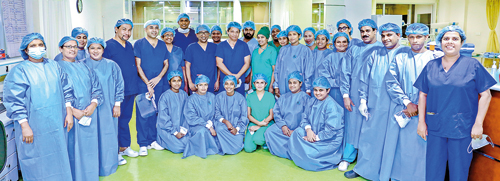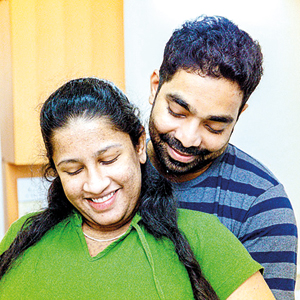Six bundles of joy at the end of a closely monitored pregnancy

A major obstetric feat: The team behind the birth of the sextuplets at Ninewells Hospital
The comfortable waiting area near the Intensive Care Unit (ICU) is deserted, except for a lone figure just about to go in.
Walking in and looking at him, there is no need for an introduction. The pair of eyes above the white face-mask of the young man is sparkling and all smiles. His whole demeanour is one of joy.
“Are you the father of the sextuplets,” I ask without hesitation.
Yes, he is!
Udayanga Marawanagoda (35) and I sit just outside the 3rd Floor ICU of Ninewells Hospitals (Pvt.) Ltd., down Kirimandala Mawatha, Narahenpita, for a leisurely chat, about 10 hours after his babies’ birth on Thursday (October 21). His mobile keeps ringing with congratulatory calls.

Dilini and Udayanga: Overjoyed
The couple had been referred to the right specialist just before Dilini Wasana Dayananda (30) reached the 12th week of this multiple pregnancy.
It was Professor in Foetal Medicine and Consultant Obstetrician and Gynaecologist, Prof. Tiran Dias attached to the Faculty of Medicine (Ragama), University of Kelaniya. Incidentally, his thesis at the University of London had been on ‘The use of ultrasound in the management of multiple pregnancies’.
Realizing that this was a sextuplet pregnancy, Prof. Dias had performed the vital ‘mapping’ of the six babies within the womb itself. Usually, if there is one baby, he explains, the growth measurement of the baby is done using a tape, externally, on the mother’s expanding abdomen. But here the need was for ultrasound measurements which would continue throughout the pregnancy.
“In a multiple pregnancy, the position or location of a particular baby in the womb remains the same throughout, with the membrane covering each one keeping him/her in that place until delivery,” says Prof. Dias.
The mapping showed the babies on the left bottom, right bottom, left middle, right middle and at the top (closer to the fundus) and the bottom (closer to the cervix) of the womb respectively. All six had their own placentas and water-bags.
The Down Syndrome scan at 11 weeks showed a low-risk and the anomaly scan performed usually at 20-22 weeks for structural deficiencies, he did on Dilini’s babies at 17 weeks, as otherwise crowding could prevent clear images.
Keeping a close eye on the pregnancy, Prof. Dias spotted the shortening of the cervix which could lead to miscarriages and took timely action through a high cervical stitch, while also keeping her on progesterone (a hormone released by the ovaries) to prevent pre-term labour. At 28 weeks, Dilini was diagnosed with pre-eclampsia (high blood pressure) and was put on single therapy.
“When she began passing protein in her urine, we faced a dilemma,” says Prof. Dias.
Should they deliver the sextuplets considering Dilini’s health? There could, however, be a problem with the survival of the babies. He and Consultant Physician Dr. Priyankara Jayawardena had a round of discussions and because the mother was positive and there were no other complications, they decided to hold on a little longer to ensure the survival of all six babies. Another issue cropped up at 30 weeks, when two babies (the largest and smallest) were having abnormal blood flows.
The full team, in one voice, agreed that the time had come to deliver the babies at 31 weeks. A ‘rehearsal’ preceded, a week before October 21st, with Ninewells Hospital promptly rectifying deficiencies and even bringing in new machines.
And so, early morn on October 21st……..at 12.16 a.m. a baby girl had been delivered in a Caesarian section along with a boy, followed at 12.17 a.m. by two boys and at 12.18 a.m. by two girls.
“The heaviest baby is a boy weighing 1.61 kg (kilograms) and the lightest baby a girl weighing 830g (grams),” says Prof. Dias.
The babies are in the Neonatal ICU.
Early on in the pregnancy, when the revelation came that they were to have six babies, both husband and wife “were on the same page”, says Udayanga.
Udayanga who is from Vavuniya and Dilini from Anuradhapura were overjoyed. They are now living off Buthgamuwa Road in the Angoda area. Dilini is an IT QA engineer and Udayanga, a mechanical design engineer.
“Many people have supported us including my widowed mother and Dilini’s parents, friends and relatives,” says Udayanga, appreciative of the unstinting help extended by his employer, Energy Solve International (Pvt.) Ltd.
He is all praise for the medical team and also the Ninewells Hospital staff, from the very top right down, who saw to their needs. “The nursing staff is wonderful,” he says.
Did he want the babies to be born at a specific time? No, says Udayanga, whenever the babies came “that was the good time” and he has left the honour of naming the little ones to his precious wife, for Dilini “loku kepa kireemak kara”.
He is the “luckiest” father in the whole world and feels it’s a “loku waasanavak”, he adds.
In this major obstetric feat, Prof. Dias was supported by his assistant Senior House Officer Dr. Chaminda Gunawardane; Consultant Neonatologists Dr.Nalin Gamaethige & Dr. Buddima Jayasinghe; Consultant Physician Dr. Priyankara Jayawardena; and Consultant Anaesthesiologists Dr. Asantha de Silva & Dr.Ranjith Dissanayake.
The logistics of baby care had been meticulously planned by experienced Medical Officer Dr. Sankalpa Marasinghe.


